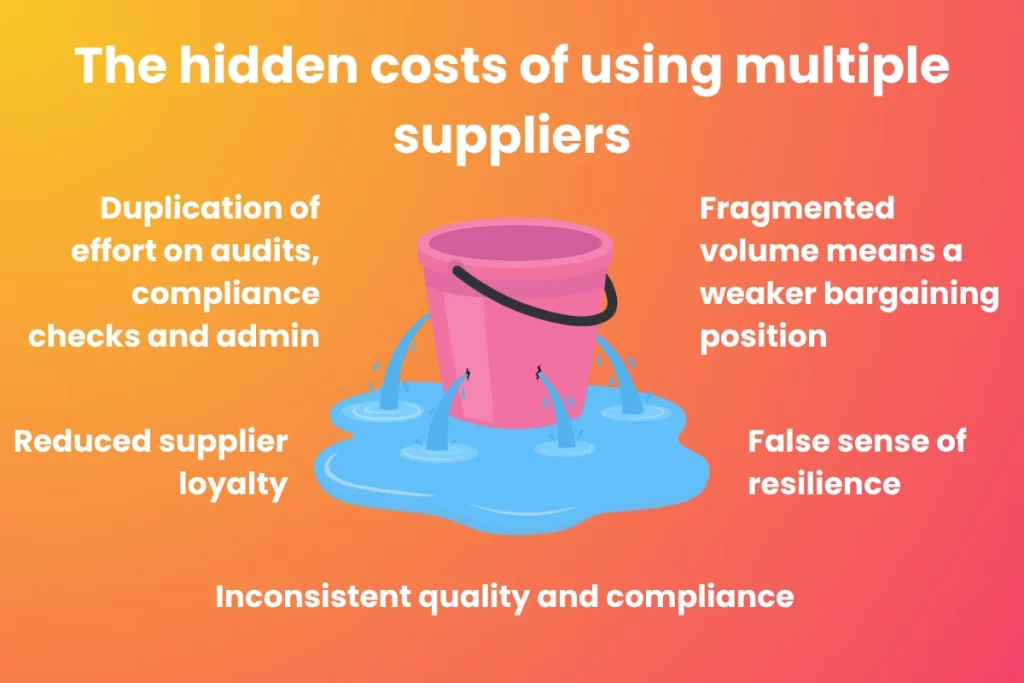
The Takeaway: Complexity Costs More Than Risk
Retailers often over-estimate the threat of single-sourcing and under-estimate the cost of complexity. Every additional supplier adds marginal cost in time, transaction, and quality control and this compounds across thousands of SKUs. Learn why supplier consolidation saves more.
With today’s volatile supply chains, retail procurement leaders continue to grapple with a central challenge: deciding whether to consolidate spend under a single supplier to unlock powerful cost savings, or proceed with caution and split spend across more suppliers to avoid over reliance on one source. So which strategy truly saves more money when ordering operational consumables and everyday supplies for example?
The answer isn’t universal, it depends on risk, category, and your ability to find and work with the right supplier or provider.
It can be likened to constantly walking the tightrope between cost and security. It’s the popular belief that spreading your purchasing with multiple providers reduces financial exposure and risk. However, in practice, juggling numerous suppliers can bleed margins and slow down operations.
For many retailers, especially in the current high-cost environment, strategic single-source procurement is consistently outperforming multi-sourcing on total cost and efficiencies.
Let’s look at how the supplier landscape has evolved.
After the pandemic, retailers rushed to grow their supplier base. Due to the perilous nature of supply during this time, it was the logical thing to do. If one factory was forced to close, others could step in – but ultimately at what cost? Since this time, many procurement teams report higher administrative burden, fragmented volumes and reduced negotiating leverage.
McKinsey notes that companies increasing the supplier base without discipline often face higher SKU costs and significantly higher procurement overheads due to contract management and coordination workload by as much as 5–10% (McKinsey & Company, 2024)1
Diversifying may protect a retailer from a black swan event but undoubtedly at the expense of everyday savings, and ultimately profitability.
Single Source procurement, or indirect purchasing, can be a positive strategy for Retailers looking to unlock volume leverage, and create deeper relationships with suppliers that deliver a consistent quality of products. There is also the potential for meaningful innovation through this better collaboration.
These are the most obvious reasons, but delving deeper, it’s about reducing those hidden costs that tend to mount up is a multi-supplier landscape.
Deliberately choosing to work with one high performing supplier is certainly not reckless, as long as contingency plans are also in the background.
It’s not about “all eggs in one basket”, it’s about owning the basket, optimising it, and making sure it never breaks.
Better volume leverage – splitting orders across multiple suppliers tends to dilute and weaken your purchasing strength. Imagine splitting your weekly shop across numerous supermarkets, it ends up costing more one way or another, even if you’re specifically shopping the deals. Travelling to numerous stores is paid in valuable time and ordering online is paid in additional delivery costs and admin processing.
Brands such as Boohoo, Tesco and Marks & Spencer have all reduced their supplier base to enable cost savings as well as creating process efficiencies.
A recent report by Inverto Retail In Transition saw that retailers consolidating suppliers were able to achieve up to 12% in cost reductions through scale effects alone2. Which Retailer wouldn’t welcome that level of cost savings right now?
Benefits of being a partner
Often when ordering the bulk, if not all, of everyday operational consumables through single source means avoiding those extra delivery costs. One of the benefits of working with one supplier could mean avoiding delivery costs entirely. Other benefits can include free warehousing and calling off stock by arrangement when required. This not only helps with storage space at an individual shop level, but it can also be of benefit for cash flow, a plus for any business.
Lower administrative overheads – using many suppliers means processing multiple estimates, quotes and invoices. Doing the in-depth due diligence required when taking on new suppliers can be extensive and time consuming with activities such as audits, contracts and compliance. Each additional vendor multiplies this area of administration. These are just some of the hidden costs that can erode any price advantages sourcing from multiple suppliers. Working with one supplier reduces the paperwork to just one monthly invoice – just imagine the time savings!
Direct cost management – having a clear picture of spend with every supplier for operational consumables for example, becomes harder to see with multiple suppliers in the picture. Effective budget tracking can become an everyday challenge but working with a supplier with an online ordering platform can deliver the detail that might have been lacking before.

“It’s great to see what people are spending and to be able to limit the products they can buy.
It gives me greater control over what is purchased with no unnecessary stockpiling”
Rainbows Hospice
Being able to track all spend in one place, spot and stop maverick or overspend instantly creates huge cost savings for any organisation. The ability to control, approve or decline spend at an individual shop level through a procurement portal such as MyAcopia means savings right across the board.
So what exactly makes multi-sourcing so expensive in practice?
The hidden costs of using multiple suppliers
Industry reports suggest teams managing multiple vendors often spend 30 to 40% of their time on administrative coordination tasks, time that could be saved through supplier consolidation (NIIT, 2024).3
“We reduced our admin time by over 50% with MyAcopia”
Rainbows Hospice
Ultimately, multiple suppliers multiply interfaces, not necessarily security.
The path to higher profitability isn’t hedging with endless vendors. It’s about trusting fewer, stronger partners and managing them rigorously.
The result? Lower total cost, faster innovation, and better supplier performance, this is the real definition of “savings.”